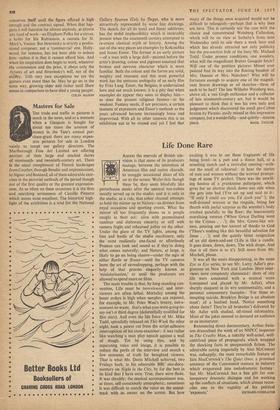Masters for Sale
THE trade and traffic in pictures is
much in the news, and at a moment When a Gauguin is bought for about ten times the amount of money in the Tate's annual pur- chase-grant there are many expen-
sive pictures for sale in London vainly to tempt our gallery directors. The Marlborough Fine Art Limited are offering another of their large and stocked shows of nineteenth- and twentieth-century art. There is the usual complement of French landscapes from Courbet, through Boudin and impressionism, to Signac and Bonnard, all of them admirable exer- cises in the pictorial methods of the period though not of the first quality or the greatest expressive- ness. As so often on these occasions it is the firm and searching seriousness of Camille Pissarro which seems most excellent. The historical high- light of the exhibition is a trial for the National Gallery Spartan Girls by Degas, who is more attractively represented by some fine drawings. The sketch, for all its tonal and linear subtleties, has the stolid implausibility which is invariably present when the nineteenth century attempted to re-create classical myth or history. Among the out-of-the-way pieces are examples by Kokoschka and James Ensor. The former is an early picture —of a man with a large doll—painted before the artist's drawing, colour and pigment assumed that broken and nervous character which is more familiar. Both the colour and the forms are solid, weighty and resonant and this most powerful work has the ominous ambiguity of an early film by Fritz Lang. Ensor, the Belgian, is undervalued here and not much known; it is a pity that when examples do appear they seem to display him— as does the present religious fantasy—at his weakest. Fantasy needs, if not precision, a certain tautness of expression and Ensor's methods as the years advanced became increasingly loose and improvised. With all its other interests this is an exhibition not to be missed and yet I feel that
many of the things once acquired would not be difficult to relinquish—perhaps that is why they are here. This is certainly not the case with the choice and concentrated Weinberg Collection, which will be on view at Sotheby's from next Wednesday until its sale there a week later and which has already attracted not only publicity but the pre-auction bids of the busy Mr. Michael Todd. Under present conditions, one wonders, what will the magnificent Breton Gauguin fetch? Will one of the prettiest pictures Monet ever painted find its way into the floating boudoir of Mrs. Onassis or Mrs. Niarchos? Who will be fortunate enough to acquire one of the magnifi- cent Seurat drawings or oil sketches—three of each to be had? The late Wilhelm Weinberg was, above all, a van Gogh enthusiast and a collector of late nineteenth-century art, but it would be pleasant to think that it was his own taste and judgement which discovered the small pre-Cubist bronze by Picasso, easily missed in this impressive company, but a wonderfully—and quietly—intense


































 Previous page
Previous page